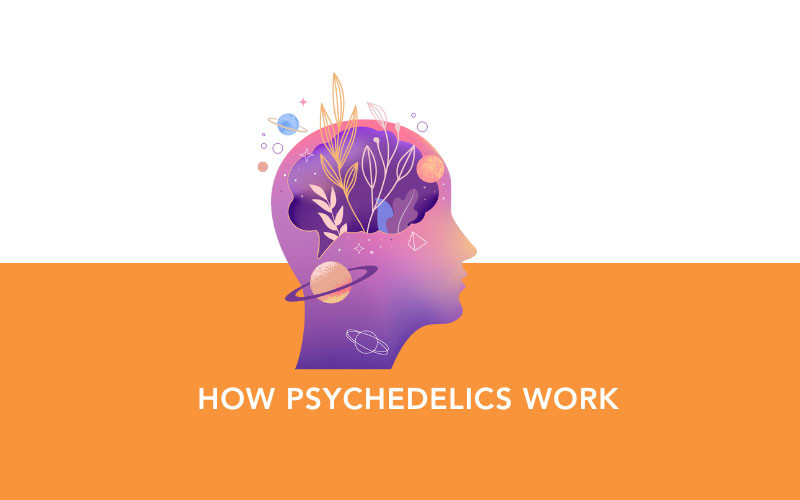How Psychedelics Work

Psychedelics (serotonergic hallucinogens) are powerful psychoactive substances that alter perception and mood and affect numerous cognitive processes. They are generally considered physiologically safe and do not lead to dependence or addiction. Classic psychedelics such as lysergic acid diethylamide (LSD) and psilocybin, are defined by their serotonergic mechanism of action. Thereby earning their name as serotonergic psychedelics.1 There has been a recent resurgence in interest in psychedelics, as some believe they may hold therapeutic potential, particularly for mental illnesses.
In the existing literature, several different explanations have been offered to explain the therapeutic effects of psychedelics. Some support mystical aspects of psychedelics whilst others have suggested that psychedelics loosen our prior beliefs, thereby providing an opportunity for adopting more positive beliefs and evaluations.2 Regarding their potential therapeutic use, the authors propose that psychedelics work to relax the precision weighting of pathologically overweighted priors underpinning various expressions of mental illness.3
A recent review by Vollenweider and Preller found that many studies have recently begun to close important knowledge gaps by elucidating the mechanisms of action of psychedelics, their effects on receptor subsystems, systems-level brain activity and connectivity, and cognitive and emotional processing. In addition, functional studies have shown that changes in self-experience, emotional processing, and social cognition may contribute to the potential therapeutic effects of psychedelics.4
Pharmacological mechanisms
Psychedelics (serotonergic hallucinogens) are powerful psychoactive substances that alter perception and mood and affect numerous cognitive processes. They are generally considered physiologically safe and do not lead to dependence or addiction. Classic psychedelics such as lysergic acid diethylamide (LSD) and psilocybin, are defined by their serotonergic mechanism of action. Thereby earning their name as serotonergic psychedelics.1 There has been a recent resurgence in interest in psychedelics, as some believe they may hold therapeutic potential, particularly for mental illnesses.
In the existing literature, several different explanations have been offered to explain the therapeutic effects of psychedelics. Some support mystical aspects of psychedelics whilst others have suggested that psychedelics loosen our prior beliefs, thereby providing an opportunity for adopting more positive beliefs and evaluations.2 Regarding their potential therapeutic use, the authors propose that psychedelics work to relax the precision weighting of pathologically overweighted priors underpinning various expressions of mental illness.3
A recent review by Vollenweider and Preller found that many studies have recently begun to close important knowledge gaps by elucidating the mechanisms of action of psychedelics, their effects on receptor subsystems, systems-level brain activity and connectivity, and cognitive and emotional processing. In addition, functional studies have shown that changes in self-experience, emotional processing, and social cognition may contribute to the potential therapeutic effects of psychedelics.4
Neurocognitive mechanisms
A review by van Elk et al outlines several different and often complementary neuroscientific explanations that have been proposed to account for the effects of psychedelics at a brain level namely (1) the thalamo-cortical filter theory, (2) the relaxed beliefs under the psychedelics (REBUS) model, and (3) the claustrocortical circuit (CCC) model.10 Each model is explained briefly below.
At a simplistic level thalmo-cortical filter theory suggests that psychedelics disrupt the normal functioning of the thalamus which is involved in sensory processing and information regulation. There is evidence to suggest LSD, psilocybin, and DMT reduce the filtering or gating function of the thalamus resulting in increased sensory permeability in the cortex. Such increases in sensory permeability may be involved in heightening colours, intensified emotions, and distorted sense of time and space experienced by some individuals when they consume psychedelics.
The CCC model proposes psychedelics disrupts the 5-HT2A-mediated network coupling between the claustrum and the cortex. This subsequently leads to attenuation of canonical cortical networks during psychedelic drug effects. Despite being a promising theory requires further refinement, particularly with regards to how and which specific canonical circuits are affected by psychedelic therapy.
The REBUS model proposes that higher-level cognitive functions are more impaired than lower-level functions (e.g., perception) to reorganise the mind. However, this model should be revised to further define what constitutes a higher or lower level of the brain or cognition.
Psychological mechanisms
Psychological mechanisms
Some of the most prominent psychological effects that have been associated with the acute subjective effects of psychedelics, include:10
1. Altered and affective states: In a double-blind study evaluating the acute and longer-term psychological effects of a high dose of psilocybin relative to a comparison compound administered under comfortable, supportive conditions, found that when psilocybin was administered under supportive conditions, psilocybin occasioned experiences were similar to spontaneously occurring mystical experiences. Some subjects reported self-transcendent experiences, and at 2 months the volunteers rated the psilocybin experience as having substantial personal meaning and spiritual significance. Sustained positive changes in attitudes and behaviour consistent with changes rated by community observers were also observed.2
2. Changes in cognition: Several studies have shown that psychedelics can increase psychological flexibility, which can be defined as the adaptive response that people can employ to different stressors to promote value-driven action. Regression analysis in a survey study (n=985) showed that acute effects (i.e., mystical and insightful effects) were significantly associated with decreases in depression/anxiety following a psychedelic experience.11
Other theories which have underlying mechanisms of action as psychological are:
3. Belief change
4. Social effects
5. Behaviour change.
Conclusion
Conclusion
Classic psychedelics induce a wide range of different effects at the pharmacological, neurocognitive, and psychological levels. To fully account for the multifaceted and dynamic nature of the psychedelic experience, new methodological developments and an open research agenda may be needed. An improved understanding of the mechanisms of actions of psychedelics will help to minimise adverse effects and hopefully allow for targeted therapies.
References
1. Nichols DE. Psychedelics. Barker EL, ed. Pharmacol Rev. 2016;68(2):264-355.
2. Griffiths RR, Richards WA, McCann U, Jesse R. Psilocybin can occasion mystical-type experiences having substantial and sustained personal meaning and spiritual significance. Psychopharmacology (Berl). 2006;187(3):268-283.
3. Carhart-Harris RL, Friston KJ. REBUS and the Anarchic Brain: Toward a Unified Model of the Brain Action of Psychedelics. Barker EL, ed. Pharmacol Rev. 2019;71(3):316-344.
4. Vollenweider FX, Preller KH. Psychedelic drugs: neurobiology and potential for treatment of psychiatric disorders. Nat Rev Neurosci. 2020;21(11):611-624.
5. Kim K, Che T, Panova O, et al. Structure of a Hallucinogen-Activated Gq-Coupled 5-HT2A Serotonin Receptor. Cell. 2020;182(6):1574-1588.e19.
6. Halberstadt AL, Geyer MA. Multiple receptors contribute to the behavioural effects of indoleamine hallucinogens. Neuropharmacology. 2011;61(3):364-381.
7. Beliveau V, Ganz M, Feng L, et al. A High-Resolution In Vivo Atlas of the Human Brain’s Serotonin System. J Neurosci. 2017;37(1):120-128.
8. Ly C, Greb AC, Cameron LP, et al. Psychedelics Promote Structural and Functional Neural Plasticity. Cell Rep. 2018;23(11):3170-3182.
9. Vollenweider FX, Kometer M. The neurobiology of psychedelic drugs: implications for the treatment of mood disorders. Nat Rev Neurosci. 2010;11(9):642-651.
10. Van Elk M, Yaden DB. Pharmacological, neural, and psychological mechanisms underlying psychedelics: A critical review. Neurosci Biobehav Rev. 2022;140:104793.
11. Davis AK, Barrett FS, Griffiths RR. Psychological flexibility mediates the relations between acute psychedelic effects and subjective decreases in depression and anxiety. J Context Behav Sci. 2020;15:39-45.

Author
Varsha Toshniwal
Medical Writer & Medical Devices Lead

